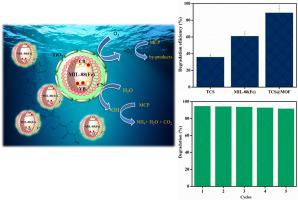Journal of Hazardous Materials ( IF 13.6 ) Pub Date : 2020-12-02 , DOI: 10.1016/j.jhazmat.2020.124728 Sivakumar Vigneshwaran , Palliyalil Sirajudheen , Perumal Karthikeyan , Manuvelraja Nikitha , Krishnapillai Ramkumar , Sankaran Meenakshi

|
In this study, we have rationally designed and grafted a bio-assisted 2D/2D TiO2/MIL-88(Fe) (TCS@MOF) heterojunction by growing granular TiO2 on the surface of MIL-88(Fe) nanosheet, as hybrid photocatalyst. The hierarchical TCS@MOF composite was prepared via the one-pot solvothermal process and employed for monocrotophos (MCP) degradation under visible light region, since its persistent nature on soil and water causes major threat to the environment. The TCS@MOF promotes a number of packed high-speed nano-tunnels in the (p-n) heterojunctions, which significantly enhance the migration of photo-induced electrons (e−) and holes (h+), respectively and thus limits the charge recombination of e−s. The optimized photocatalyst achieves significant catalytic activity of ~98.79% for the degradation of MCP within 30 min of irradiation. The prominent oxidative radicals namely •OH, •O2− etc., were involved in the oxidation of organic pesticide. Besides, TCS@MOF exhibits outstanding stability even after five repetitive cycles for the oxidation of MCP with a negligible decrease in photo-activity. The proposed mechanism and oxidative pathways of MCP were rationally deduced in detail subject to experimental results. The mechanism renders insight into the oxidation and consequent bond rupture of pollutant as well as into the formation of products such as H2O, CO2, etc. This report unveils a novel architecture of proficiently optimized TCS@MOF material structure for the perceptive oxidation of organic contaminants.
中文翻译:

固定化MIL-88(Fe)固定的TiO 2-壳聚糖(2D / 2D)杂化纳米复合材料降解有机磷酸盐农药的特性,机理和降解中间体
在这项研究中,我们通过在MIL-88(Fe)纳米片的表面上生长颗粒状的TiO 2来合理设计并接枝了生物辅助的2D / 2D TiO 2 / MIL-88(Fe)(TCS @ MOF)异质结。杂化光催化剂。TCS @ MOF分层复合材料是通过一锅溶剂热法制备的,并用于可见光区域的久效磷(MCP)降解,因为它在土壤和水中的持久性对环境造成了重大威胁。的TCS @ MOF促进了(PN)异质结一些打包高速纳米隧道,其显著提高光诱导电子(e迁移- )和空穴(h +分别地),因而限制了电荷重组电子商务-s。优化的光催化剂在辐照后30分钟内对MCP的降解具有约98.79%的显着催化活性。突出氧自由基即•OH,•Ø 2 -等,参与了有机农药的氧化。此外,即使经过五个重复的MCP氧化循环,TCS @ MOF仍具有出色的稳定性,而光活性的降低可忽略不计。根据实验结果合理推导了MCP的机理和氧化途径。该机制使人们深入了解了污染物的氧化和随之而来的键断裂,以及诸如H 2 O,CO 2之类的产物的形成。等等。本报告揭示了一种经过优化的TCS @ MOF材料结构的新颖体系结构,用于有机污染物的感知氧化。



























 京公网安备 11010802027423号
京公网安备 11010802027423号